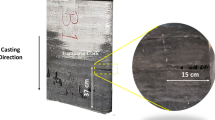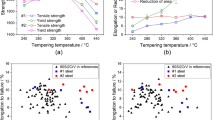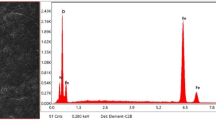Abstract
Al-Si-Mg aluminum alloy samples were subjected to solution heat treatment at the temperature of 520 °C for 2 h to attain T42 condition. The heat-treated samples were quenched further in air and water mediums. After quenching, the fatigue life was analyzed with the total strain amplitude (TSA) of 0.4% at the cyclic frequency of 0.3 Hz using a low cycle fatigue testing machine. Air quenched sample has higher life with 1286 cycles than heat-treated and water quenched sample, which were having a fatigue life of 836 cycles and 708 cycles. Tensile mean stress was observed in all samples due to residual stress. Due to fatigue striation, ripple formation was observed in the air quenched sample, and the ripple having the size of 2-3 μm observed under SEM fractography. XRD peaks of Mg2Si and Al3Fe precipitates confirm the proper dispersion during the solution heat treatment.
Similar content being viewed by others
References
Totten GE, Webster GM, Bates CE (2003) In: Totten GE and MacKenzie DS (eds) Handbook of aluminum. CRC Press, Florida
Croucher T (1982) Quenching of aluminum alloys: what this key step accomplishes. Heat Treat 14:20–21
Bates CE, Totten GE (1988) Procedure for quenching media selection to maximize tensile properties and to minimize distortion in aluminum-alloy parts. Heat Treat Met 4:89–98
Ridhwan J, Noor JA, Zakaria MS et al (2014) Effect of heat treatment on microstructure and mechanical properties of 6061 aluminum alloy. J Eng Technol 5:89–98
Ridhwan J, Hamzah E, Selamat MZ, Zulfattah Z, Hafidzal MHM (2013) Effect of aging treatment on the microstructures and hardness of Fe-Ni-Cr Superalloy. Int J Automot Mech Eng 8:1430–1441
Fragoudakis R, Karditsas S, Savaidis G, Michailidis N (2014) The effect of heat and surface treatment on the fatigue behaviour of 56SiCr7 spring steel. Procedia Eng 74:309–312
Zaiedah Nasir N, Mohd Daud MA, Selamat MZ, Rivai A, Dhar Malingam S (2014) The effect of heat treatment on fatigue and mechanical properties of 6061 Aluminium alloy. Appl Mech Mater 699:227–232
Nandy S, Sekhar AP, Das D, Hossain SJ, Ray KK (2016) Influence of dynamic precipitation during low cycle fatigue of under-aged AA6063 alloy. Trans Indian Inst Metals 69:319–324
Khalil O, Lang KH (2011) Influence of microstructure on the quasistatic and low cycle fatigue behaviour of an AA2618 aluminium alloy. Procedia Engineering 10:1339–1347. https://doi.org/10.1016/j.proeng.2011.04.223
Frodal BH, Christiansen E, Myhr OR, Hopperstad OS (2020) The role of quench rate on the plastic flow and fracture of three aluminium alloys with different grain structure and texture. Int J Eng Sci 150:103257
Liu S, Zhang M, Li Q, Zhu Q, Song H, Wu X, Cao L, Couper MJ (2020) Effect of quenching rate on strengthening behavior of an Al-Zn-mg-cu alloy during natural ageing. Mater Sci Eng A 793:139900
Kwofie S, Chandler HD (2001) Low cycle fatigue under tensile mean stresses where cyclic life extension occurs. Int J Fatigue 23:341–345
Winter L, Hockauf K, Winter S, Lampke T (2020) Equal-channel angular pressing influencing the mean stress sensitivity in the high cycle fatigue regime of the 6082 aluminum alloy. Mater Sci Eng A 795:140014
Bassindale C, Miller RE, Wang X (2020) Effect of single initial overload and mean load on the low-cycle fatigue life of normalized 300 M alloy steel. Int J Fatigue 130:105273
Branco R, Costa JD, Borrego LP, Wu SC, Long XY, Antunes FV (2020) Effect of tensile pre-strain on low-cycle fatigue behaviour of 7050-T6 aluminium alloy. Eng Fail Anal 114:104592
Paul SK (2020) Correlation between endurance limit and cyclic yield stress determined from low cycle fatigue test. Materialia 11:100695
Zhao Z, Chen X (2020) Effect of cyclic softening and stress relaxation on fatigue behavior of 2.25Cr1Mo0.25V steel under strain-controlled fatigue-creep interaction at 728 K. Int J Fatigue 140:105848
Wang R-Z, Zhang X-C, Tu S-T, Zhu SP, Zhang CC (2016) A modified strain energy density exhaustion model for creep–fatigue life prediction. Int J Fatigue 90:12–22
Senthil Kumar M et al (2019) Processing and characterization of AA2024/Al2O3/SiC reinforces hybrid composites using squeeze casting technique. Iran J Mater Sci Eng 16(2):55–67
Blochwitz C, Heinrich D, Frenzel R (1989) Microcrack propagation in fatigued F.c.c. monocrystals I: crack-depth distribution and propagation rate. Mater Sci Eng A 118:71–81
Kundu A, Field DP, Chandra Chakraborti P (2019) Influence of strain amplitude on the development of dislocation structure during cyclic plastic deformation of 304 LN austenitic stainless steel. Mater Sci Eng A 762:138090
Papakyriacou M, Mayer H, Pypen C, Plenk Jr H, Stanzl-Tschegg S (2001) Influence of loading frequency on high cycle fatique properties of b.c.c and h.c.p. metals. Mater Sci Eng A 308:143–152
Schneider N, Bödecker J, Berger C, Oechsner M (2016) Frequency effect and influence of testing technique on the fatigue behaviour of quenched and tempered steel and aluminium alloy. Int J Fatigue 93:224–231
Srivatsan TS (1988) Mechanisms of damage in high-temperature, low cycle fatigue of an aluminium alloy. Int J Fatigue 10:91–99
Srivatsan TS (1999) Mechanisms governing cyclic deformation and failure during elevated temperature fatigue of aluminum alloy 7055. Int J Fatigue 21:557–569
Fujii T, Watanabe C, Nomura Y et al (2001) Microstructural evolution during low cycle fatigue of a 3003 aluminum alloy. Mater Sci Eng A 319–321:592–596
Natrayan L, Senthil kumar M, Palanikumar K. (2018) Optimization of squeeze cast process parameters on mechanical properties of Al2O3/SiC reinforced hybrid metal matrix composites using taguchi technique. Mater Res Expr 5(6):066516
Eswara Prasad N, Vogt D, Bidlingmaier T, Wanner A, Arzt E (2000) High temperature, low cycle fatigue behaviour of an aluminium alloy (Al–12Si–CuMgNi). Mater Sci Eng A 276:283–287
Ding H-ZZ, Biermann H, Hartmann O (2003) Low cycle fatigue crack growth and life prediction of short-fibre reinforced aluminium matrix composites. Int J Fatigue 25:209–220
Fatemi A, Plaseied A, Khosrovaneh AK, Tanner D (2005) Application of bi-linear log–log S–N model to strain-controlled fatigue data of aluminum alloys and its effect on life predictions. Int J Fatigue 27:1040–1050
Zheng X, Engler-Pinto CCC, Su X et al (2013) Modeling of fatigue damage under superimposed high-cycle and low-cycle fatigue loading for a cast aluminum alloy. Mater Sci Eng A 560:792–801
Zeng L, Li Z, Che R, Shikama T, Yoshihara S, Aiura T, Noguchi H (2014) Mesoscopic analysis of fatigue strength property of a modified 2618 aluminum alloy. Int J Fatigue 59:215–223
Shaha SKK, Czerwinski F, Kasprzak W et al (2016) Effect of transition metals on energy absorption during strain-controlled fatigue of an aluminum alloy. Int J Fatigue 87:456–470
Nellessen J, Sandlöbes S, Raabe D (2016) Low cycle fatigue in aluminum single and bi-crystals: on the influence of crystal orientation. Mater Sci Eng A 668:166–179
Jiang H, Sandlöbes S, Gottstein G, Korte-Kerzel S (2017) On the effect of precipitates on the cyclic deformation behavior of an Al–mg–Si alloy. J Mater Res 32:4398–4410
Natrayan L, Kumar MS (2020) Influence of silicon carbide on tribological behaviour of AA2024/Al2O3/SiC/gr hybrid metal matrix squeeze cast composite using Taguchi technique. Mater Res Expr 6:1265f9
Natrayan L, Senthil Kumar M (2020) An integrated artificial neural network and Taguchi approach to optimize the squeeze cast process parameters of AA6061/Al2O3/SiC/gr hybrid composites prepared by novel encapsulation feeding technique. Mater Today Commun 25:101586
Moffat AJ, Barnes S, Mellor BG, Reed PAS (2005) The effect of silicon content on long crack fatigue behaviour of aluminium-silicon piston alloys at elevated temperature. Int J Fatigue 27(10–12):1564–1570
Dong XG, Zhou J, Jia YJ, Liu B (2012) Effect of alloying on high temperature fatigue performance of ZL114A (Al-7Si) alloy. Trans Nonferrous Metals Soc China 22:661–667
González JA, Talamantes-Silva J, Valtierra S, Colás R (2017) Fatigue in a heat treatable high silicon containing aluminium alloy. J Phys IOP Conf Ser 843:12027
Shomran AT, Hussein EK, Shomran HT, Gaaz TS, Takriff MS, Kadhum AAH, al-Amiery AA (2020) Investigation of adding silicon on fatigue properties of aluminum based alloys. Silicon. https://doi.org/10.1007/s12633-020-00500-7
Standard Practice for Heat Treatment of Aluminum-Alloy Castings from All Processes, ASTM International B917/B917M-12. ASTM Book of Standards, 2012. https://doi.org/10.1520/B0917
Agnew S, Weertman J (1998) Cyclic softening of ultrafine grain copper. Mater Sci Eng A 244:145–153
Kavalco PM, Canale LCF, Totten GE (2009) Quenching fundamentals; quenching of aluminum alloys: cooling rate, strength, and Intergranular corrosion. http://web.archive.org/web/20200828034324/https://www.asminternational.org/c/portal/pdf/download?articleId=HTP00907P25&groupId=10192. Accessed 2 Aug 2019
Karakaş Ö, Szusta J (2016) Monotonic and low cycle fatigue behaviour of 2024-T3 aluminium alloy between room temperature and 300 °C for designing VAWT components. Fatigue Fract Eng Mater Struct 39:95–109
Zhou H, He Y, Zhang H, Cen Y (2013) Influence of dynamic strain aging pre-treatment on the low-cycle fatigue behavior of modified 9Cr-1Mo steel. Int J Fatigue 47:83–89
Yin SY, Chen LJ, Wang X (2011) Influence of heat treatment on low-cycle fatigue behavior of AZ61 magnesium alloy. Adv Mater Res 287–290:883–887
Suresh S (1988) Fatigue of materials2nd edn. Cambridge University Press, Cambridge
Begum S, Chen DL, Xu S, Luo AA (2009) Low cycle fatigue properties of an extruded AZ31 magnesium alloy. Int J Fatigue 31:726–735
Begum S, Chen DL, Xu S, Luo AA (2008) Strain-controlled low-cycle fatigue properties of a newly developed extruded magnesium alloy. Metall Mater Trans A 39:3014–3026
Jordon JB, Horstemeyer MF, Solanki K, Xue Y (2007) Damage and stress state influence on the Bauschinger effect in aluminum alloys. Mech Mater 39:920–931
Cáceres C, Sumitomo T, Veidt M (2003) Pseudoelastic behaviour of cast magnesium AZ91 alloy under cyclic loading–unloading. Acta Mater 51:6211–6218
Wang Q, Liu W, Wu G, Chen X, Zhang H (2017) Influence of heat treatment on cyclic deformation and low-cycle fatigue behavior of sand-cast mg–10Gd–3Y–0.5Zr magnesium alloy. J Mater Res 32:2179–2187
Noster U, Scholtes B (2003) Isothermal strain-controlled quasi-static and cyclic deformation behavior of magnesium wrought alloy AZ31. Zeitschrift fuer Met Res Adv Tech 94:559–563
Hasegawa S, Tsuchida Y, Yano H, Matsui M (2007) Evaluation of low cycle fatigue life in AZ31 magnesium alloy. Int J Fatigue 29:1839–1845
Dieter GE (1988) Mechanical metallurgy. McGraw-Hill, New York
Sommer C, Christ H-J, Mughrabi H (1991) Non-linear elastic behaviour of the roller bearing steel SAE 52100 during cyclic loading. Acta Metall Mater 39:1177–1187
McDowell D, Gall K, Horstemeyer M, Fan J (2003) Microstructure-based fatigue modeling of cast A356-T6 alloy. Eng Fract Mech 70:49–80
Mirza FA, Chen DL, Li DJ, Zeng XQ (2013) Low cycle fatigue of a rare-earth containing extruded magnesium alloy. Mater Sci Eng A 575:65–73
Hemmouche L, Fares C, Belouchrani MA (2013) Influence of heat treatments and anodization on fatigue life of 2017A alloy. Eng Fail Anal 35:554–561. https://doi.org/10.1016/j.engfailanal.2013.05.003
Srivatsan TS (1991) The low-cycle fatigue and cyclic fracture behaviour of 7150 aluminium alloy. Int J Fatigue 13:313–321. https://doi.org/10.1016/0142-1123(91)90358-6
Kumar S, Namboodhiri TKG (2011) Precipitation hardening and hydrogen embrittlement of aluminum alloy AA7020. Bull Mater Sci 34:311–321
Leszczyńska-Madej B, Richert M, Wąsik A, Szafron A (2017) Analysis of the microstructure and selected properties of the Aluminium alloys used in automotive air-conditioning systems. Metals (Basel) 8:10
Nowotnik GM, Sieniawski J, Wierzbiñska M et al (2007) Intermetallic phase particles in 6082 aluminium alloy. Arch Mater Sci Eng 28:69–76
Acknowledgments
The authors thank SASTRA Deemed University for its financial assistance.
Availability of Data and Material
The datasets analyzed during the current study are available from the corresponding author on reasonable request.
Funding
This work is supported by the “Research and Modernization fund, SASTRA University” grant number R&M/0035/SoME-008/2015–16.
Author information
Authors and Affiliations
Contributions
Ramesh Kumar S: Supervision, Methodology, Writing- Reviewing and Editing.
SreeArravind M: Investigation, Conceptualization, Software, Writing, Editing.
Corresponding author
Ethics declarations
This article does not contain any studies with human participants or animals performed by any of the authors.
Conflict of Interest
The authors declare that they have no conflict of interest.
Consent to Participate
Not applicable.
Consent for Publication
Not applicable.
Additional information
Publisher’s Note
Springer Nature remains neutral with regard to jurisdictional claims in published maps and institutional affiliations.
Rights and permissions
About this article
Cite this article
Kumar, S.R., SreeArravind, M. Influence of Si Content on Fatigue Life for Heat Treated Cast Al-Si-mg Alloy Using Different Quenching Technique. Silicon 14, 977–987 (2022). https://doi.org/10.1007/s12633-020-00874-8
Received:
Accepted:
Published:
Issue Date:
DOI: https://doi.org/10.1007/s12633-020-00874-8




